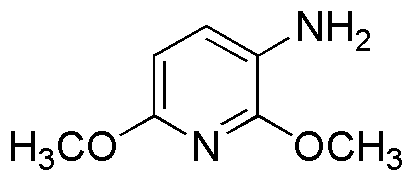3-Amino-2,6-dimethoxypyridine is widely utilized in research focused on:
- Pharmaceutical Development: This compound serves as a building block in the synthesis of various pharmaceuticals, particularly those targeting neurological disorders. Its unique structure can enhance the efficacy of drug candidates.
- Agricultural Chemicals: It is used in the formulation of agrochemicals, providing improved efficacy in pest control products. The compound can enhance the activity of herbicides and fungicides, making them more effective against resistant strains.
- Material Science: This chemical plays a role in the development of advanced materials, particularly in creating polymers with enhanced thermal and mechanical properties. Its incorporation can lead to more durable and efficient materials.
- Biochemical Research: Researchers utilize it as a reagent in various biochemical assays, aiding in the study of enzyme activity and metabolic pathways. Its ability to interact with biological systems makes it valuable for exploring cellular processes.
- Analytical Chemistry: The compound is employed in analytical techniques, such as chromatography, to separate and identify complex mixtures. Its distinct properties allow for more precise measurements and better resolution in analytical applications.
General Information
Properties
Safety and Regulations
Applications
3-Amino-2,6-dimethoxypyridine is widely utilized in research focused on:
- Pharmaceutical Development: This compound serves as a building block in the synthesis of various pharmaceuticals, particularly those targeting neurological disorders. Its unique structure can enhance the efficacy of drug candidates.
- Agricultural Chemicals: It is used in the formulation of agrochemicals, providing improved efficacy in pest control products. The compound can enhance the activity of herbicides and fungicides, making them more effective against resistant strains.
- Material Science: This chemical plays a role in the development of advanced materials, particularly in creating polymers with enhanced thermal and mechanical properties. Its incorporation can lead to more durable and efficient materials.
- Biochemical Research: Researchers utilize it as a reagent in various biochemical assays, aiding in the study of enzyme activity and metabolic pathways. Its ability to interact with biological systems makes it valuable for exploring cellular processes.
- Analytical Chemistry: The compound is employed in analytical techniques, such as chromatography, to separate and identify complex mixtures. Its distinct properties allow for more precise measurements and better resolution in analytical applications.
Documents
Safety Data Sheets (SDS)
The SDS provides comprehensive safety information on handling, storage, and disposal of the product.
Product Specification (PS)
The PS provides a comprehensive breakdown of the product’s properties, including chemical composition, physical state, purity, and storage requirements. It also details acceptable quality ranges and the product's intended applications.
Certificates of Analysis (COA)
Search for Certificates of Analysis (COA) by entering the products Lot Number. Lot and Batch Numbers can be found on a product’s label following the words ‘Lot’ or ‘Batch’.
Numéro de catalogue
Numéro de lot/série
Certificates Of Origin (COO)
This COO confirms the country where the product was manufactured, and also details the materials and components used in it and whether it is derived from natural, synthetic, or other specific sources. This certificate may be required for customs, trade, and regulatory compliance.
Numéro de catalogue
Numéro de lot/série
Safety Data Sheets (SDS)
The SDS provides comprehensive safety information on handling, storage, and disposal of the product.
DownloadProduct Specification (PS)
The PS provides a comprehensive breakdown of the product’s properties, including chemical composition, physical state, purity, and storage requirements. It also details acceptable quality ranges and the product's intended applications.
DownloadCertificates of Analysis (COA)
Search for Certificates of Analysis (COA) by entering the products Lot Number. Lot and Batch Numbers can be found on a product’s label following the words ‘Lot’ or ‘Batch’.
Numéro de catalogue
Numéro de lot/série
Certificates Of Origin (COO)
This COO confirms the country where the product was manufactured, and also details the materials and components used in it and whether it is derived from natural, synthetic, or other specific sources. This certificate may be required for customs, trade, and regulatory compliance.

